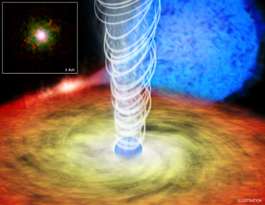This artist's illustration depicts the jet of relativistic particles blasting out of Circinus X-1, a system where a neutron star is in orbit with a star several times the mass of the Sun. X-ray: NASA/CXC/Univ. of Wisconsin-Madison/S.Heintz et al.; Illustration: NASA/CXC/M.Weiss
A team of astronomers has discovered a neutron star emitting an extended stream of powerful X rays, marking the first time such an extended X-ray jet has been detected originating from any class of object other than black holes.
"This discovery shows that the unusual properties of black holes -- such as the lack of an actual surface -- may not be required to form powerful X-ray jets, as was previously thought," said Penn State Professor of Astronomy and Astrophysics Niel Brandt, one of the scientists on the team that made the discovery with NASA's Chandra X-ray Observatory.
The discovery, which is described in a paper recently published in The Astrophysical Journal Letters, may help astronomers to understand how X-ray jets can erupt from a neutron star -- the extremely dense ball of tightly packed neutrons that remains after a more "normal" star has exploded at the end of its lifetime. "We found the X-ray jet in our Milky Way Galaxy in Circinus X-1, a binary system in which the neutron star is in orbit around a star several times the mass of the Sun, about 20,000 light years from Earth," Brandt said. "Circinus X-1 shows clear evidence for X-ray jets, indicating that our Galaxy contains a bona fide microquasar," said Brandt, who was instrumental in interpreting the data received by Chandra. Microquasars are small-scale versions of much-more-powerful quasars, which are among the most-luminous and most-distant known objects in the universe.
The researchers speculate that gravity may be the key to creating X-ray jets -- black holes and neutron stars both have massive gravitational fields. The discovery of this jet also reveals how efficient neutron stars can be as cosmic power factories. The research team estimates that a surprisingly high percentage of the energy available from material falling onto the neutron star is converted into powering the jet. "In terms of energy efficiency across the universe, this result shows that neutron stars are near the top of the list," said Norbert Schulz, a coauthor from the Massachusetts Institute of Technology in Cambridge. "This jet is almost as efficient as one from a black hole."
The Chandra results also help to explain the origin of diffuse lobes of radio emission previously detected around Circinus X-1. The team found the X-ray jets of high-energy particles are powerful enough to create and maintain these balloons of radio-emitting gas. "We've seen enormous radio clouds around supermassive black holes at the centers of galaxies," said Sebastian Heinz, an astronomer at the University of Wisconsin and the lead author of the scientific paper. "What's unusual here is that this pocket-sized version, relatively speaking, is being powered by a neutron star, not a black hole."
The main evidence for the newly found jet comes in two extended features in the Chandra data. These two fingers of X-ray emission are separated by about 30 degrees and may represent the outer walls of a wide jet. When overlapped with radio images, these X-ray features, which are at least five light years from the neutron star, closely trace the outline of the radio jet.
Another interpretation is that these two features represent two separate, highly collimated jets produced at different times by a neutron star that wobbles like a top as it spins, causing the jet to fire at different angles at different times. This wobbling "precession" of the jet also is consistent with radio observations taken at different times, which show varying orientation angles of the jet. If the precession scenario is correct, Circinus X-1 would possess one of the longest, narrowest jets found in X-ray binary systems to date, representing yet another way in which neutron stars can rival, and even outdo, their larger black-hole relatives.
"Circinus X-1 shows such a wealth of fascinating accretion physics that an exciting new discovery seems to come with each new X-ray observation," said Brandt.
Source:
























